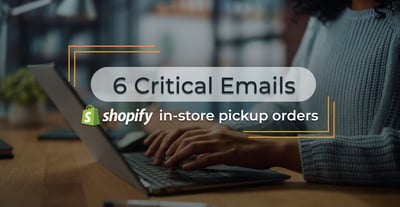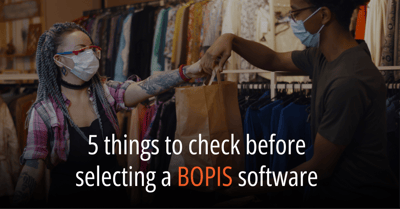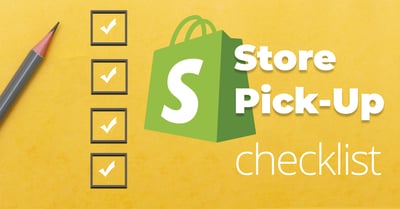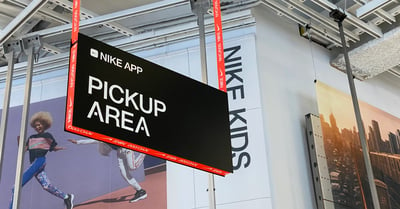We’ve all heard the benefits of omnichannel order management. Omnichannel retail strategies like BOPIS (buy online pick-up in store) and ship from store promise to increase online conversions, average order values, and in-store foot traffic all at once. But how often do we hear about the concrete data points and return-on-investment (ROI) of the omnichannel order management strategies that help brands operate in an increasingly competitive retail environment? Do retailers know if and when omnichannel strategies like BOPIS are working for them or generating a real positive return on their investment
In this blog, we will walk you through how to calculate the ROI of your BOPIS initiative to demonstrate how ROI can be calculated for your omnichannel order management journey at large. We also provide you with a hypothetical business case that you can apply to your own brand.
Setting The Stage
Imagine a retail brand with 10 brick-and-mortar locations and an eCommerce website that is eager to implement omnichannel order management strategies to delight its increasingly demanding customer base. We’ll call this brand Classy Clothing Boutique. We will be using conservative estimates to walk you through this brand’s adoption of BOPIS in order to demonstrate the minimum return on investment that your own company can expect.
Each Classy Clothing Boutique brick-and-mortar location generates 20 orders per day on average, totaling 7,300 orders per year per store with an average order value of $100. Meanwhile, the Classy Clothing eCommerce website generates 50 orders per day on average, also with an average order value of $100. For simplicity’s sake, let’s assume that each order comes from a unique customer (a.k.a no repeat customers).
To be extremely conservative, we will assume only a 5% adoption rate of BOPIS for Classy Clothing’s brick-and-mortar customers (although, based on industry benchmarks e, it could be as high as 60%). For the purpose of this exercise, let’s say 5% of the 7,300 customers at each Classy Clothing brick-and-mortar location will take advantage of BOPIS, converting 365 of their expected orders into BOPIS orders per year per store.
Increased Sales
A recent Forbes study found that 85% of BOPIS customers buy something additional when they arrive in store to pick up their order. Continuing with our conservative estimates, let’s assume only 50% of Classy Clothing’s BOPIS customers decide to make an additional purchase. So, out of 365 BOPIS customers per store, 182 will pick something up on their way to the cash register that they wouldn’t have purchased otherwise. Additional sales are generally equal to 20-30% of the value of the original item, so let’s take an average and assume that those 182 BOPIS customers purchase an additional $25 worth of product, increasing the average order value for these 182 customers to $125, resulting in $4,550 in additional sales per store. Already, you can see that their omnichannel order management strategy is generating significant additional revenue!
Return on Investment
According to our highly conservative business case, Classy Clothing is generating $4,550 in additional sales revenue per store annually. If we assume the same results across all brick-and-mortar locations, that means Classy Clothing has added $45,500 in top-line revenue.
Our calculations so far have focused only on brick-and-mortar customers who are taking advantage of your new BOPIS option, however we know that omnichannel order management is channel-agnostic. Many of your online customers will take advantage of this option to get their orders faster and cheaper instead of waiting for a delivery.
According to ICSC, for online sales with in-store pick-ups and returns, retailers can expect a net sale of 107%. (ICSC’s full article outlines the methodology of this input.) Let’s apply these numbers to Classy Clothing, yielding a net increase in online sales of $127,750.
Overall, our business case shows that, using very conservative estimates, Classy Clothing has increased top-line revenue by a total of $173,250, which amounts to 1.9% of total annual sales revenue. This calculation does not even touch on the cost-savings that Classy Clothing will experience due to reduced shipping and delivery fees afforded by their omnichannel order management strategy.
* * *
The purpose of this business case exercise is to demonstrate that, even using the most conservative estimates, you can expect to increase annual sales revenue by 1.9% simply by implementing buy online pick-up in-store (and if you use the industry benchmark of 60% BOPIS adoption by brick-and-mortar customers and 85% upsell once in-store, annual sales revenue increases by up to 11.6%). But as we know, BOPIS is just one of the many omnichannel retail strategies that brands are turning to in order to delight customers and maximize revenue in an increasingly demanding retail environment. The ROI for other omnichannel strategies can be calculated in a similar fashion.
Every retailer out there has heard of buy online pick-up in store and has either implemented BOPIS or is on its way. This blog demonstrates that an impressive return on investment (ROI) of omnichannel order management strategies is worth seriously considering both as a means of improving the customer experience and as a means of supporting business growth. Request a consultation with HotWax Commerce’s team of experts to learn how we can help you achieve the best return on inventory through omnichannel retailing strategies.









